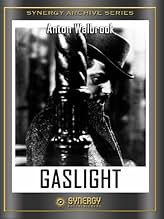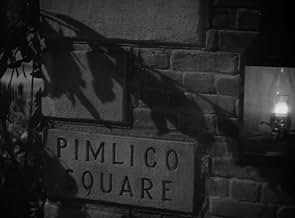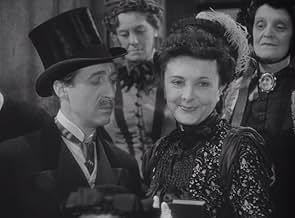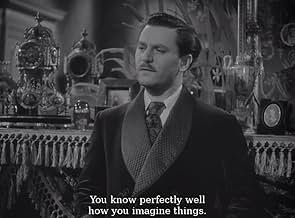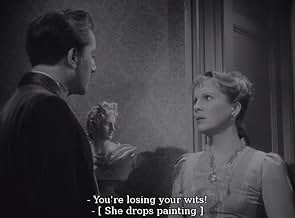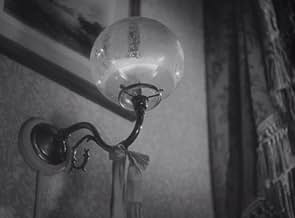VALUTAZIONE IMDb
7,3/10
5697
LA TUA VALUTAZIONE
Aggiungi una trama nella tua linguaTwenty years after the murder of Alice Barlow, her house is finally occupied again. However, the husband from the couple who has moved in has a secret that he will do anything to keep hidden... Leggi tuttoTwenty years after the murder of Alice Barlow, her house is finally occupied again. However, the husband from the couple who has moved in has a secret that he will do anything to keep hidden.Twenty years after the murder of Alice Barlow, her house is finally occupied again. However, the husband from the couple who has moved in has a secret that he will do anything to keep hidden.
- Regia
- Sceneggiatura
- Star
Alfred Atkins
- Bit Role
- (non citato nei titoli originali)
Edwin Ellis
- Bit Role
- (non citato nei titoli originali)
Kathleen Harrison
- Bit Role
- (non citato nei titoli originali)
Katie Johnson
- Alice Barlow's Maid
- (non citato nei titoli originali)
Molly Raynor
- Bit Role
- (non citato nei titoli originali)
Recensioni in evidenza
From what I've been reading we're fortunate to have this film at all much less showing for rent on Amazon. Not unlike what Paramount did with Frank Capra's Broadway Bill when that studio made Riding High, MGM destroyed this original British made version of Gaslight that came out four years before MGM remade it with Charles Boyer, Ingrid Bergman and Joseph Cotten, that classic that won Ingrid Bergman her first Oscar. Fortunately MGM was not thorough and we can enjoy Diana Wynyard and Anton Walbrook in this original film version of the play Angel Street.
It might have been nice to have a version of that surviving as well. On stage Vincent Price played the suave husband who is trying to get his wife to question her sanity, he co-starred with Judith Evelyn in the Patrick Hamilton play that ran 1295 performances on Broadway from 1941 to 1944. I can see Price easily doing this part.
Of course it would be without the continental suavity of both Charles Boyer and here, Anton Walbrook. Walbrook is one both cold and cool and cruel customer as he tries to drive Wynyard out of her mind. She's at a loss to explain his change toward her. In point of fact she's accidentally discovered a clue to his real identity and he's had history with her family before. She doesn't know what she's discovered which makes her all the more frightened. Wynyard is every bit as good as Bergman in the remake.
The major change that MGM made was in the policeman's role. In fact there is some reason to speculate that Scotland Yard man Joseph Cotten may end up with Bergman in the MGM version. Here the dogged detective is British character actor Frank Pettengill who's strictly business. He recognizes Walbrook, but can't prove anything without positive identification.
Gaslight remains firmly fixed in the Victorian era it is set. Today what involved an elaborate scheme of deception by Pettengill could be remedied easily with fax and telephotos to Australia where Walbrook presumably was staying for many years.
This version of Gaslight is every bit the equal of the finely mounted MGM version and since it is closer to what author Hamilton had in mind, many consider it superior. It's pretty darn good any way you slice it.
It might have been nice to have a version of that surviving as well. On stage Vincent Price played the suave husband who is trying to get his wife to question her sanity, he co-starred with Judith Evelyn in the Patrick Hamilton play that ran 1295 performances on Broadway from 1941 to 1944. I can see Price easily doing this part.
Of course it would be without the continental suavity of both Charles Boyer and here, Anton Walbrook. Walbrook is one both cold and cool and cruel customer as he tries to drive Wynyard out of her mind. She's at a loss to explain his change toward her. In point of fact she's accidentally discovered a clue to his real identity and he's had history with her family before. She doesn't know what she's discovered which makes her all the more frightened. Wynyard is every bit as good as Bergman in the remake.
The major change that MGM made was in the policeman's role. In fact there is some reason to speculate that Scotland Yard man Joseph Cotten may end up with Bergman in the MGM version. Here the dogged detective is British character actor Frank Pettengill who's strictly business. He recognizes Walbrook, but can't prove anything without positive identification.
Gaslight remains firmly fixed in the Victorian era it is set. Today what involved an elaborate scheme of deception by Pettengill could be remedied easily with fax and telephotos to Australia where Walbrook presumably was staying for many years.
This version of Gaslight is every bit the equal of the finely mounted MGM version and since it is closer to what author Hamilton had in mind, many consider it superior. It's pretty darn good any way you slice it.
Let's face it - the British do psychological suspense VERY well! This 1940 British production is more streamlined and suspenseful than the MGM version of 1944, as it sticks more closely to Patrick Hamilton's play. The MGM version had more 'back-story' and padding to it. I love Diana Wynyard - she was lovely to look at and seemed wonderfully edgy and vulnerable - I wasn't surprised to learn that she played the anguished mother in the West End production of THE BAD SEED - she's really only remembered today for this film and CAVALCADE (1933), but she's definitely worth watching. Anton Walbrook is a little hammier than Boyer was, and there are those obvious streaks in his hair to make him look a little older - but he has a wonderful moment at the films end when, quite suddenly, his eyes go wild and you can tell that he's completely lost his mind - might have been a nice touch if the 1944 had included such a moment. Highly recommended.
I've noticed that people seem surprised that MGM attempted to suppress the 1940 British version of GASLIGHT to avoid any competition with their version. I don't know why anyone should be surprised - Hollywood's business is a cut-throat one: remember that L.B. Mayer, along with Jack Warner and others, offered to buy CITIZEN KANE from RKO and then destroy it, all to appease William R. Hearst - fortunately they didn't (just imagine the history of film since 1941 if they had!) And although MGM didn't destroy all prints of GASLIGHT, they did manage to keep it out of sight for many years - I think I first saw it on a cable station in the early 1980s - I tuned in expecting Boyer and Bergman and got Walbrook and Wynyard - as it turned out I didn't mind at all, and have enjoyed it many times since! MGM did the same thing with Paramount's 1932 DR. JEKYLL AND MR. HYDE which, except for an occasional screening, went unseen (but much written about) until it came out on video around 1990 (under the MGM label - imagine that!)
I've noticed that people seem surprised that MGM attempted to suppress the 1940 British version of GASLIGHT to avoid any competition with their version. I don't know why anyone should be surprised - Hollywood's business is a cut-throat one: remember that L.B. Mayer, along with Jack Warner and others, offered to buy CITIZEN KANE from RKO and then destroy it, all to appease William R. Hearst - fortunately they didn't (just imagine the history of film since 1941 if they had!) And although MGM didn't destroy all prints of GASLIGHT, they did manage to keep it out of sight for many years - I think I first saw it on a cable station in the early 1980s - I tuned in expecting Boyer and Bergman and got Walbrook and Wynyard - as it turned out I didn't mind at all, and have enjoyed it many times since! MGM did the same thing with Paramount's 1932 DR. JEKYLL AND MR. HYDE which, except for an occasional screening, went unseen (but much written about) until it came out on video around 1990 (under the MGM label - imagine that!)
Gaslight (1940) In 1944, MGM released a movie about a thief who slowly tries to drive his wife insane in order to find out the location of some jewels. The movie was called Gaslight, and it starred Charles Boyer and Ingrid Bergman. But the movie wasn't an MGM original by any means; its antecedent was a much-lesser-known 1940 British film by the same name. (Apparently, when MGM bought the rights to the story, based on a play by Patrick Hamilton, the studio attempted to destroy all existing prints of the earlier version, but they weren't successful.) In the opening scene, an old woman is strangled to death, and her killer ransacks her apartment in search of... well, something. His search is apparently fruitless. Years later, Paul Mallen (Anton Walbrook), a debonair society lord in London, moves with his wife Bella (Diana Wynyard) to the posh Pimlico Square, directly below the apartment of the murdered. Mrs. Mallen is quickly the talk of the neighborhood - she's a little off, they say. Something's not quite right with her. And those wags are right; Bella is constantly accused by her husband of stealing things from him, although she has no recollection of the events.
Mallen uses trick after psychological trick against his wife, although it's unclear to the audience what his motives are. Is he just playing with her? Does he merely delight in her anguish? He even deliberately keeps her from her cousin, a man who'd stood against their marriage at the wedding ceremony. What's Mallen's angle? Unlike its remake, this earlier version is delightfully understated - and bereft of stars whose names would be recognizable in the United States. It's remarkably well lit, too, typical for movies of the period. But where it draws most of its strength is from the two leads. Walbrook, who by that time had been in motion pictures for 25 years, is perfect as the sly, debonair, and viciously evil Mallen; Wynyard exudes vulnerability and panic; her Bella is terrified that she might be quite sincerely insane, vacillating from dignified serenity to sheer panic.
This movie is highly recommended to fans of noir film, particularly those who've seen the more-famous 1944 Hollywood version.
Mallen uses trick after psychological trick against his wife, although it's unclear to the audience what his motives are. Is he just playing with her? Does he merely delight in her anguish? He even deliberately keeps her from her cousin, a man who'd stood against their marriage at the wedding ceremony. What's Mallen's angle? Unlike its remake, this earlier version is delightfully understated - and bereft of stars whose names would be recognizable in the United States. It's remarkably well lit, too, typical for movies of the period. But where it draws most of its strength is from the two leads. Walbrook, who by that time had been in motion pictures for 25 years, is perfect as the sly, debonair, and viciously evil Mallen; Wynyard exudes vulnerability and panic; her Bella is terrified that she might be quite sincerely insane, vacillating from dignified serenity to sheer panic.
This movie is highly recommended to fans of noir film, particularly those who've seen the more-famous 1944 Hollywood version.
I have liked the Gaslight films for many years and was surprised and delighted recently to find both versions together on an American DVD ! Miracles will never cease, I thought!
I have read various comments from people trying to compare these two films. I will not fall into this trap - I liked each film as much as the other..true, Walbrook looks more evil as a villain than Charles BOyer, and the 1940 version is perhaps a little more picturesque with the sets ( carriages, children etc ) but both films were very well done. The picture quality of the 1944 version is obviously better than that of 1940, and I had read somewhere that they had actually tried to get the print of the 1940 version destroyed as to have only the 1944 version available. What a horrible thought that someone could actually have wanted to do that !
So, they are both great suspense films and the black and white only serves to enhance the already seedy atmosphere ! Well worth several viewings !!!
I have read various comments from people trying to compare these two films. I will not fall into this trap - I liked each film as much as the other..true, Walbrook looks more evil as a villain than Charles BOyer, and the 1940 version is perhaps a little more picturesque with the sets ( carriages, children etc ) but both films were very well done. The picture quality of the 1944 version is obviously better than that of 1940, and I had read somewhere that they had actually tried to get the print of the 1940 version destroyed as to have only the 1944 version available. What a horrible thought that someone could actually have wanted to do that !
So, they are both great suspense films and the black and white only serves to enhance the already seedy atmosphere ! Well worth several viewings !!!
Although Ingrid Bergman and Charles Boyer got a lot of press for the movie GASLIGHT, the film was actually a remake of a British film made only a few years earlier. It seems that the big-wigs at the studio wanted to remake the film but pretend that it was an original Hollywood production so they bought up the prints and the remade film went on to be considered a "classic". However, recently the ORIGINAL version from 1940 has been discovered and has been shown on Turner Classic Movies.
Having seen both versions, I found them awfully similar--but I would have to say that I preferred the original. The wonderful Anton Walbrook was a wonderful and even more menacing husband and I just could see no reason why the movie should have been remade. It's really a shame, too, as I am sure that those associated with the original must have wished they'd gotten all the attention the 1944 version received.
My advice is see them both. However, if you only plan on seeing one, see this one--it's just a better film!
Having seen both versions, I found them awfully similar--but I would have to say that I preferred the original. The wonderful Anton Walbrook was a wonderful and even more menacing husband and I just could see no reason why the movie should have been remade. It's really a shame, too, as I am sure that those associated with the original must have wished they'd gotten all the attention the 1944 version received.
My advice is see them both. However, if you only plan on seeing one, see this one--it's just a better film!
Lo sapevi?
- QuizWhen MGM remade the film with Charles Boyer and Ingrid Bergman, the studio attempted to have all prints of this earlier version destroyed. Fortunately, several prints escaped the fire (in fact, it is believed that director Thorold Dickinson surreptitiously struck a print himself before the negative was lost).
- BlooperAfter the murder of the old lady in 1865, a police constable is shown blowing a whistle to summon assistance. Whistles were not used by the Metropolitan Police until the 1870s; prior to that they used a football rattle to attract attention.
- ConnessioniFeatured in The Kenny Report: Episodio datato 3 settembre 2024 (2024)
- Colonne sonoreThe Can-Can
(uncredited)
from "Orpheus in the Underworld"
Music by Jacques Offenbach
Arranged by Richard Addinsell
Played at the music hall and danced to by The Darmora Ballet
I più visti
Accedi per valutare e creare un elenco di titoli salvati per ottenere consigli personalizzati
- How long is Angel Street?Powered by Alexa
Dettagli
- Tempo di esecuzione1 ora 24 minuti
- Colore
- Proporzioni
- 1.37 : 1
Contribuisci a questa pagina
Suggerisci una modifica o aggiungi i contenuti mancanti


